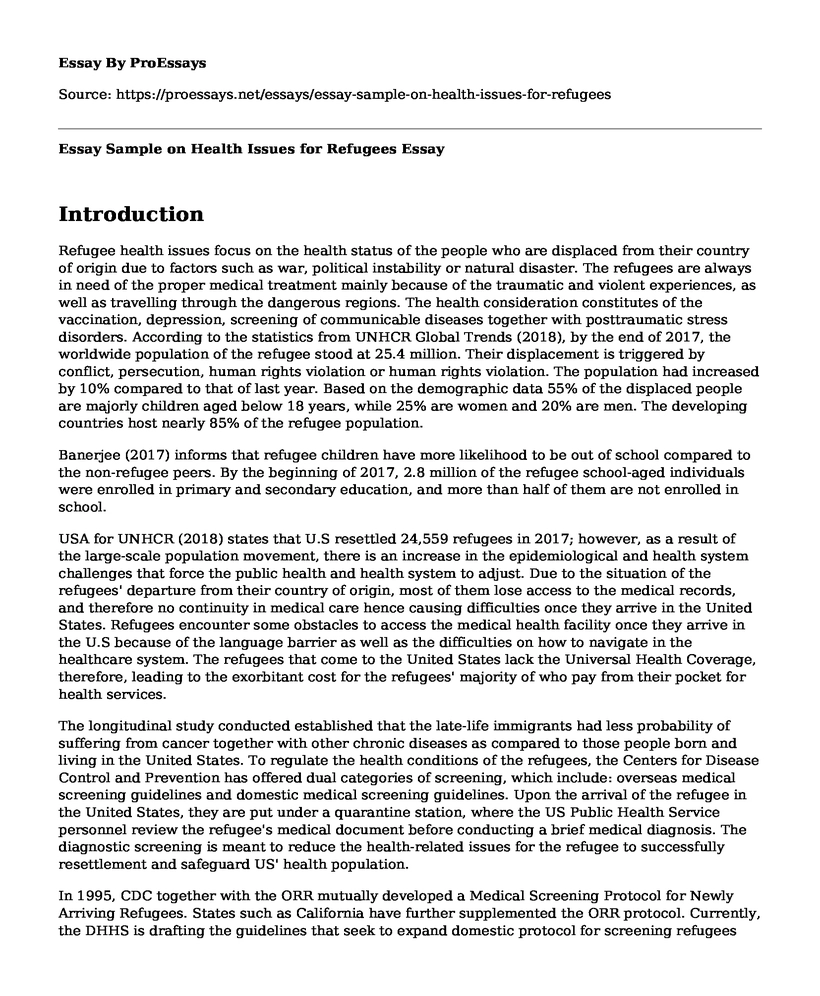Introduction
Refugee health issues focus on the health status of the people who are displaced from their country of origin due to factors such as war, political instability or natural disaster. The refugees are always in need of the proper medical treatment mainly because of the traumatic and violent experiences, as well as travelling through the dangerous regions. The health consideration constitutes of the vaccination, depression, screening of communicable diseases together with posttraumatic stress disorders. According to the statistics from UNHCR Global Trends (2018), by the end of 2017, the worldwide population of the refugee stood at 25.4 million. Their displacement is triggered by conflict, persecution, human rights violation or human rights violation. The population had increased by 10% compared to that of last year. Based on the demographic data 55% of the displaced people are majorly children aged below 18 years, while 25% are women and 20% are men. The developing countries host nearly 85% of the refugee population.
Banerjee (2017) informs that refugee children have more likelihood to be out of school compared to the non-refugee peers. By the beginning of 2017, 2.8 million of the refugee school-aged individuals were enrolled in primary and secondary education, and more than half of them are not enrolled in school.
USA for UNHCR (2018) states that U.S resettled 24,559 refugees in 2017; however, as a result of the large-scale population movement, there is an increase in the epidemiological and health system challenges that force the public health and health system to adjust. Due to the situation of the refugees' departure from their country of origin, most of them lose access to the medical records, and therefore no continuity in medical care hence causing difficulties once they arrive in the United States. Refugees encounter some obstacles to access the medical health facility once they arrive in the U.S because of the language barrier as well as the difficulties on how to navigate in the healthcare system. The refugees that come to the United States lack the Universal Health Coverage, therefore, leading to the exorbitant cost for the refugees' majority of who pay from their pocket for health services.
The longitudinal study conducted established that the late-life immigrants had less probability of suffering from cancer together with other chronic diseases as compared to those people born and living in the United States. To regulate the health conditions of the refugees, the Centers for Disease Control and Prevention has offered dual categories of screening, which include: overseas medical screening guidelines and domestic medical screening guidelines. Upon the arrival of the refugee in the United States, they are put under a quarantine station, where the US Public Health Service personnel review the refugee's medical document before conducting a brief medical diagnosis. The diagnostic screening is meant to reduce the health-related issues for the refugee to successfully resettlement and safeguard US' health population.
In 1995, CDC together with the ORR mutually developed a Medical Screening Protocol for Newly Arriving Refugees. States such as California have further supplemented the ORR protocol. Currently, the DHHS is drafting the guidelines that seek to expand domestic protocol for screening refugees (Centers for Disease Control and Prevention, 2016). In California the scope of the domestic health screening comprises of:
- Follow up the process, which includes the evaluation, referral or/and treatment, of Class A and B conditions noted on the overseas medical exam.
- Person's identification process, it targets people who have communicable diseases of potential public health significance that were not detectable during or came up after the overseas exam.
- Introduction of the incoming refugees to the US healthcare system
- Identifying the conditions that could create the barrier to self-sufficiency
References
Banerjee, K. (2017). Rethinking the Global Governance of International Protection. Colum. J. Transnat'l L., 56, 313.
Centers for Disease Control and Prevention. (2016). Guidelines for the US domestic medical examination for newly arriving refugees. Atlanta, GA, USA Google Scholar.
Hall, E., & Cuellar, N. G. (2016). Immigrant health in the United States: A trajectory toward change. Journal of Transcultural Nursing, 27(6), 611-626.
UNHCR Global Trends (2018) - Forced Displacement in 2017. Retrieved from http://www.unhcr.org/globaltrends2017/
USA for UNHCR (2018). Refugee Statistics Retrieved from https://www.unrefugees.org/refugee-facts/statistics/
Cite this page
Essay Sample on Health Issues for Refugees. (2022, Mar 28). Retrieved from https://proessays.net/essays/essay-sample-on-health-issues-for-refugees
If you are the original author of this essay and no longer wish to have it published on the ProEssays website, please click below to request its removal:
- Nuclear Weapons Do Not Matter Essay Example
- The Failure of FDA of Rofecoxib Case Study Paper Example
- Immigrants and Firms Productivity Essay Example
- Essay Example on No Legal Age of Consent for Medical Treatment in Ontario
- Essay on Gender Inequality in Education: Impact on Learners & Teachers
- Women's Fight for Equality: The Second Wave of Feminism - Essay Sample
- Paper on Normal Microflora & Opportunistic Infections: Causes of Candidiasis







